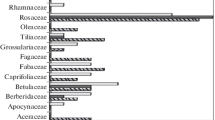Abstract
The patterns of leaf pathogen attack and mechanisms of infection in the canopy of a Mexican tropical rain forest are described based on a survey of 30 tree and liana species. The study included the identification of the causal agents of pathogenic damage, as well as a description of the magnitude, interspecific and seasonal variation of leaf damage. Foliage of all tree species was attacked by fungal pathogens that caused leaf spots. Sixty two percent of the leaves surveyed in the dry season (N = 4348), and 59% of the leaves surveyed in the wet season (N = 3077) showed evidence of damage by fungal pathogens. Overall, leaf area damaged per plant was very low and similar in both seasons (≤ 5% of leaf area damaged). Within the low levels of damage, there was considerable variation in the degree of infection among species: the percentage of diseased leaves ranged from 12 to 97.19, while leaf area damaged per plant ranged from 0.90 to 12.54%. A salient pattern of the survey is that 59% of the leaves in the dry season and 54% of the leaves surveyed in the wet season were concurrently attacked by herbivores and fungal pathogens, and only between 2 and 4% of the leaves bore damage by pathogens alone (dry and wet seasons respectively). Pathogenicity assays experimentally confirmed that the predominant mechanism of fungal establishment was wounding, such as that caused by herbivory and only rarely did infection occur through direct contact (without wounds). This study reveals that leaf fungal diseases are a prevalent component of the foliage in the tropical rain forest canopy, although the magnitude of affected leaf area is considerably low.
Similar content being viewed by others
References
Agrios G.N. 1997. Plant pathology. Academic Press, New York.
Barone J.A. 1998. Host-specificity of folivorous insects in a moist tropical forest. Journal of Animal Ecology 67: 400-409.
Barone J.A. 2000. Comparison of herbivores and herbivory in the canopy and understory of two tropical tree species. Biotropica 32: 307-317.
Basset Y. 2001. Do specific arthropods forage in the upper canopy layer of rainforests? Examples from the closed forests of Africa. In: Ganeshaiah K.N., Uma Shaanker R.U. and Bawa K.S. (eds), Tropical ecosystems: Structure, diversity and human welfare. Oxford & IBH Publishing Co. Pvt. Ltd., New Delhi, pp. 395-398.
Burdon J.J. 1987. Disease and plant population biology. Cambridge University Press, Cambridge.
Coley P.D. 1986. Costs and benefits of defence by tannins in a neotropical tree. Oecologia 70: 238-241.
Corff J.L. and Marquis R.J. 1999. Differences between understorey and canopy in herbivore community composition and leaf quality for two oak species in Missouri. Ecological Entomology 24: 46-58.
Daniels J.D. and Lawton R.O. 1993. Natural history of Ficus crassiuscula. Selbyana 14: 59-63.
del Amo R.S., Ramírez J.G. and Espejo O. 1986. Variation of some secondary metabolites in juvenile stages of three plant species from tropical rain forest. Journal of Chemical Ecology 12: 2021-2038.
Dirzo R. 1987. Estudios sobre interacciones planta-herbivoro en “Los Tuxtlas”, Veracruz. Revista de Biología Tropical 35: 119-131.
Dirzo R. and Domínguez C.A. 1995. Plant-herbivore interactions in Mesoamerican tropical dry forests. In: Bullock S.H., Mooney H.A. and Medina E. (eds), Seasonal dry tropical forests. Cambridge University Press, Cambridge, pp. 304-325.
Dirzo R., González S.E. and Vogt R.C. 1997. Introducción general. In: González S.E., Dirzo R. and Vogt R.C. (eds), Historia Natural de Los Tuxtlas. Universidad Nacional Autónoma de México, Mexico, pp. 3-6.
Evans D. and O'Dowd D.J 1995. Life on the forest phylloplane: Hairs, little houses, and myriad mites. In: Lowman M.D. and Nadkarni N.M. (eds), Forest canopies. Academic Press, San Diego, pp. 325-51.
García-Guzmán G. and Dirzo R. 2001. Patterns of leaf-pathogen infection in the understory of a Mexican rain forest: Incidence, spatiotemporal variation, and mechanisms of infection. American Journal of Botany 88: 634-645.
Gilbert G.S. 1995. Rain forest plant diseases: The canopy-understory connection. Selbyana 16: 75-77.
Gilbert G.S. and Hubbell S.P. 1996. Plant diseases and the conservation of tropical forests. BioScience 46: 98-106.
González S.E., Dirzo R. and Vogt R.C. 1997. Historia Natural de Los Tuxtlas. Universidad Nacional Autónoma de México, Mexico.
Ibarra M.G., Martínez-Ramos M., Dirzo R. and Núñez-Farfán J. 1997. La vegetación. In: González S.E., Dirzo R. and Vogt R.C. (eds), Historia Natural de Los Tuxtlas. Universidad Nacional Autónoma de México, Mexico, pp. 72-85.
Ingram D. and Robertson N. 1999. Plant disease. Harper Collins Publishers, London.
Lodge D.J. and Cantrell S. 1995. Fungal communities in wet tropical forests: variation in time and space. Canadian Journal of Botany 73: 1391-1398.
Marquis R.J., Diniz I.R. and Morais H.C. 2001. Patterns and correlates of interspecific variation in foliar insect herbivory and pathogen attack in Brazilian cerrado. Journal of Tropical Ecology 17: 127-148.
Paul N.D. and Ayres P.G. 1986. The effects of infection by rust (Puccinia lagenophorae Cooke) on the growth of groundsel (Senecio vulgaris L.) cultivated under a range of nutrient concentrations. Annals of Botany 58: 321-331.
Reynolds K.M., Bulger M.A., Madden L.V. and Ellis M.A. 1987. New methods using simulated rain to study the splash dispersal of plant pathogen. Phytopathology 77: 921-926.
Rhoades F.M. 1995. Nonvascular epiphytes in forest canopies: Worldwide distribution, abundance, and ecological roles. In: Lowman M.D. and Nadkarni N.M. (eds), Forest canopies. Academic Press, San Diego, pp. 353-408.
Soto E.M. and Gama L. 1997. Climas. In: González S.E., Dirzo R. and Vogt R.C. (eds), Historia Natural de Los Tuxtlas. Universidad Nacional Autónoma de México, Mexico, pp. 7-23.
Author information
Authors and Affiliations
Corresponding author
Rights and permissions
About this article
Cite this article
García-Guzmán, G., Dirzo, R. Incidence of leaf pathogens in the canopy of a Mexican tropical wet forest. Plant Ecology 172, 41–50 (2004). https://doi.org/10.1023/B:VEGE.0000026034.24664.73
Issue Date:
DOI: https://doi.org/10.1023/B:VEGE.0000026034.24664.73




